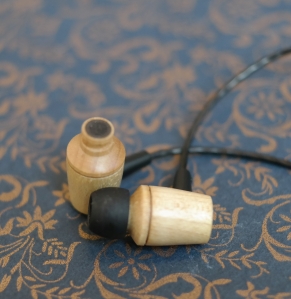The C-12s are hand-made IEMs made from Indian company, Signature Acoustics. A newcomer to the scene, it seems Signature Acoustics is creating some differentiation by creating hand-made, wooden IEMs.
Overview
- Driver: 8mm dynamic
- Impedance: 18 ohms
- Frequency: 17 – 20 kHz
- Sensitivity: 102 dB
For around $60 (AUD) these are a budget earphone that performs very well for its price and are a little bit special due to their wooden construction. Of course, there’s more you’ll want to know than just that though so read on for all the details…
Design & Comfort
 I’ve already mentioned that the C-12s are made of wood so I won’t harp on it. It is worth noting though that being handmade does mean there will be some minor variation from one unit to the next and the casings may not be 100% perfect. For example, you may be able to see in the image above that the groove around the earphone at the front of the photo is of varying width because the earphones haven’t been assembled perfectly. It seems to have no impact on the sound and is only noticeable if you look closely so I really don’t think this matters and it’s always nice to know that someone has personally put their care, attention and expertise into creating a product so I’m fine with the minor aesthetic imperfections. It’s also really nice having a beautifully crafted wooden Y-split complete with a slider so that earns points in my book.
I’ve already mentioned that the C-12s are made of wood so I won’t harp on it. It is worth noting though that being handmade does mean there will be some minor variation from one unit to the next and the casings may not be 100% perfect. For example, you may be able to see in the image above that the groove around the earphone at the front of the photo is of varying width because the earphones haven’t been assembled perfectly. It seems to have no impact on the sound and is only noticeable if you look closely so I really don’t think this matters and it’s always nice to know that someone has personally put their care, attention and expertise into creating a product so I’m fine with the minor aesthetic imperfections. It’s also really nice having a beautifully crafted wooden Y-split complete with a slider so that earns points in my book.
 In terms of comfort, the C-12 comes with a fairly basic range of silicon single-flange tips and the sound port is the same as the HiFiMan earphones so there are plenty of tips around that will fit the C-12s. My ears are fairly tricky to get a comfortable fit with when using a universal so it’s no surprise that the C-12s aren’t perfectly comfortable, but the Re-272s and Shure SE535s are the only universals I’ve found so far that were 100% comfortable so this is more about me than the C-12s. Overall, I would expect the C-12s to be as comfortable as the majority of other IEMs for most people. If you struggle to get a comfortable fit, these might not be for you, but if most earphones are OK for you there’s no reason to not consider the C-12s.
In terms of comfort, the C-12 comes with a fairly basic range of silicon single-flange tips and the sound port is the same as the HiFiMan earphones so there are plenty of tips around that will fit the C-12s. My ears are fairly tricky to get a comfortable fit with when using a universal so it’s no surprise that the C-12s aren’t perfectly comfortable, but the Re-272s and Shure SE535s are the only universals I’ve found so far that were 100% comfortable so this is more about me than the C-12s. Overall, I would expect the C-12s to be as comfortable as the majority of other IEMs for most people. If you struggle to get a comfortable fit, these might not be for you, but if most earphones are OK for you there’s no reason to not consider the C-12s.
Supplied Accessories
In addition to the range of tips, the C-12s come with a beautiful brass storage case. I doubt you’d use it as a carry case because it’s really heavy, but it’s a really nice storage case to keep on a desk or in a draw with your earphones safe and sound. I wonder though if it’s a bit of a mismatch to have a fairly deluxe style container for a relatively budget IEM. Perhaps a cheaper case and some extra tips would be a better inclusion.
The other things provided with the C-12s are a lapel clip to hold the cable and 2 different sets of filters to tweak the sound to your personal preferences. I’ll discuss these in more detail below.
Sound Quality
The price tag of the C-12s might leave you expecting little, but there are various budget IEMs out there now offering great performance and the C-12 seems to be targeted at the same market. The overall signature of the C-12s is warm and smooth with a slight emphasis on bass. It’s an inoffensive sound and easy to enjoy, but let’s look more closely…
Treble
 This is probably the weakest part of the C-12s signature. The treble is just a bit too rolled off and it leaves the overall sound feeling a bit murky and thick. The provided filters (the mesh you can see on top of one of the IEMs in the image to the right) allow you to tweak the sound, but none of them really open up the treble quite enough. It’s very hard to tell if the pre-fitted filters are the middle of the 3 or the most open. One set is definitely for a much darker sound, but the other is so similar to the pre-fitted ones that I had a hard time distinguishing the difference by the time I removed the IEMs, change filters and got them back in my ears.
This is probably the weakest part of the C-12s signature. The treble is just a bit too rolled off and it leaves the overall sound feeling a bit murky and thick. The provided filters (the mesh you can see on top of one of the IEMs in the image to the right) allow you to tweak the sound, but none of them really open up the treble quite enough. It’s very hard to tell if the pre-fitted filters are the middle of the 3 or the most open. One set is definitely for a much darker sound, but the other is so similar to the pre-fitted ones that I had a hard time distinguishing the difference by the time I removed the IEMs, change filters and got them back in my ears.
In the end, what really matters is that there is no configuration of filters or tips that could produce quite enough treble extension to make these sound as open and detailed as they probably should. With no filter at all, the C-12s start to approach a better balance of treble energy, but I imagine just one small amount of ear-wax in a tiny driver like this could be curtains so I wouldn’t recommend filter-free use and only tried it myself for the briefest time to see what the starting signature is like. Doing so showed me that the C-12 probably started a little too dark before the filters were applied and it had nowhere to go. Had the starting sound included just a little more treble energy, these could have been really magic. As it is, despite the quoted 20kHz frequency peak, it sounds like there is fairly significant roll-off before about 16kHz and it leaves the C-12s lacking that little bit of air that would help them feel more spacious and alive.
I know I’ve just spent 2 paragraphs bemoaning the C-12s treble, but all is not lost. The treble that is present is of great quality – smooth and refined – and the relative lack of treble energy means there’s zero fatigue from the C-12s. For people who enjoy a laid-back listening experience, the C-12s are still worth considering so read on!
Mids
The C-12 offers a nice, creamy mid-range with plenty of detail and texture. It’s a little bit coloured and not entirely even across all mid-range frequencies, but it’s enjoyable nonetheless. These aren’t IEMs you’d use for analysis or monitoring – they’re IEMs purely for relaxed listening to music.
Vocals are clear and present with good body whether it’s a male or female vocalist. Overall, the tonality of the mids is quite neutral the majority of the time with the exception of some slight upper bass bloat which can muddy the mid-range on some tracks, but this is more an exception than the rule. All-in-all I find the C-12’s mid-range enjoyable and a little seductive. I wonder if the wooden housing is the cause for the overall warmth and the nice timbre of most vocals and instrumental presentation.
Bass
The C-12s were clearly tuned to have a nice prominent bass with punch and presence, but not too much bloat. They’re not the final word in bass control, but the bass is really good for the most part. Bass lines sing through the music, you can feel some kick and thump in your ears and with a few exceptions (as mentioned above), the bass mostly stays in its own lane and doesn’t interfere with higher registers. There’s plenty of extension down deep and on some tracks, the depth and subtlety of the rumble I was hearing and feeling was really impressive.
Summary
 If this is the first foray into earphones from Signature Acoustics (which I believe it might be) it’s an excellent start. They probably need to make a few adjustments (like starting with a brighter driver to put inside their beautiful, but warm sounding wooden shells), but this first effort is very well priced for its quality of build and sound.
If this is the first foray into earphones from Signature Acoustics (which I believe it might be) it’s an excellent start. They probably need to make a few adjustments (like starting with a brighter driver to put inside their beautiful, but warm sounding wooden shells), but this first effort is very well priced for its quality of build and sound.
I wouldn’t recommend this for people who enjoy bright, airy sounding ‘phones, but it’s worth checking out if you’re looking for a well-priced, laid-back cruisy earphone with great bass. Think of the C-12 as a budget earphone representing something similar in overall signature to an LCD-2 or HD650 (not that it performs to the same level, but it has the same laid-back type of signature).
I’m keenly waiting to see what Signature Acoustics might offer up next because the value for money of the C-12 is excellent, their design is really nice, and the overall result is only a few adjustments from being a serious giant killer. To get a better sounding, but similarly voiced earphone you need to spend nearly twice as much on something like the thinksound TS01 so it’s a really good start from Signature Acoustics!

